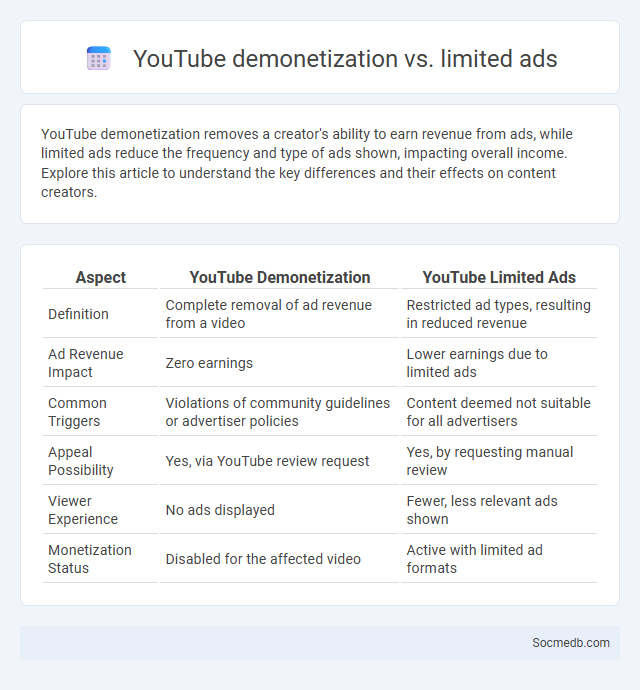
Photo illustration: YouTube demonetization vs limited ads
YouTube demonetization removes a creator's ability to earn revenue from ads, while limited ads reduce the frequency and type of ads shown, impacting overall income. Explore this article to understand the key differences and their effects on content creators.
Table of Comparison
| Aspect | YouTube Demonetization | YouTube Limited Ads |
|---|---|---|
| Definition | Complete removal of ad revenue from a video | Restricted ad types, resulting in reduced revenue |
| Ad Revenue Impact | Zero earnings | Lower earnings due to limited ads |
| Common Triggers | Violations of community guidelines or advertiser policies | Content deemed not suitable for all advertisers |
| Appeal Possibility | Yes, via YouTube review request | Yes, by requesting manual review |
| Viewer Experience | No ads displayed | Fewer, less relevant ads shown |
| Monetization Status | Disabled for the affected video | Active with limited ad formats |
Understanding YouTube’s Monetization Policies
YouTube's monetization policies require creators to comply with community guidelines, copyright rules, and advertiser-friendly content standards to earn revenue. Your channel must have at least 1,000 subscribers and 4,000 watch hours in the past 12 months to qualify for the YouTube Partner Program. Understanding these policies helps you optimize content and maximize your income through ads, memberships, and Super Chats.
What Is YouTube Demonetization?
YouTube demonetization refers to the process where videos or channels lose their eligibility to earn ad revenue due to violations of YouTube's Community Guidelines or advertiser-friendly content policies. This often happens when content is flagged as inappropriate, harmful, or not suitable for advertisers, resulting in limited or no ads shown on affected videos. Demonetization significantly impacts creators' income streams by restricting monetization opportunities and reducing potential earnings from their content.
Exploring the “Limited Ads” Status
The "Limited Ads" status on social media platforms restricts ad delivery due to compliance issues or policy violations, impacting campaign reach and effectiveness. Advertisers encountering this status must review platform-specific guidelines, such as Facebook's Advertising Policies, to identify prohibited content or targeting restrictions causing the limitation. Understanding and resolving the "Limited Ads" status ensures optimized ad performance and sustained audience engagement across social media channels.
Full Demonetization: Causes and Consequences
Full demonetization on social media platforms occurs when content creators lose all monetization privileges due to violations of community guidelines or advertiser policies, often triggered by misinformation, hate speech, or harmful content. This drastic measure directly impacts creators' revenue streams and can lead to significant shifts in content strategy, audience engagement, and platform trustworthiness. Consequences include reduced content diversity, increased self-censorship among creators, and potential migration to alternative platforms with more lenient monetization policies.
Key Differences: Demonetization vs. Limited Ads
Demonetization on social media involves completely disabling a content creator's ability to earn revenue from ads, often due to guideline violations or unsuitable content. Limited ads restrict the number or type of ads shown on a creator's content, resulting in reduced revenue while still allowing some monetization. Both strategies impact creator earnings but differ in scope, with demonetization being a total monetization block and limited ads representing a partial revenue reduction.
Common Reasons for Losing Ad Revenue
You may lose ad revenue on social media due to decreased engagement rates, ad fatigue, or targeting inefficiencies that reduce the effectiveness of your campaigns. Algorithm changes on platforms like Facebook and Instagram often limit organic reach, forcing higher ad spend for less impact. Poor ad quality or failing to comply with platform policies can also lead to lower ad impressions and revenue loss.
How Content Types Trigger Limited Ads or Demonetization
Certain social media content types, such as videos featuring controversial topics, sensitive subjects, or copyright-protected material, often trigger limited ads or demonetization due to platform policies. Graphic violence, hate speech, and sexually explicit content receive stricter scrutiny, reducing ad revenue opportunities for creators. Algorithms use automated detection tools to identify and restrict monetization on content that violates advertiser-friendly guidelines.
Tips to Avoid Demonetization and Limited Ads
To protect your content from demonetization and limited ads on social media platforms, ensure compliance with community guidelines by avoiding sensitive topics such as violence, hate speech, and adult content. Use clear, advertiser-friendly language and maintain originality to enhance your video's suitability for monetization. You can also regularly review platform updates to adapt your content strategy and maximize your revenue potential.
The Impact of Monetization Restrictions on Creators
Monetization restrictions on social media platforms significantly affect creators' revenue streams, limiting their ability to earn through ads, sponsorships, and fan support. These policies often lead to decreased content output and reduced audience engagement as creators struggle to sustain their livelihoods. Understanding platform-specific guidelines and adapting content strategies are crucial for creators aiming to navigate monetization challenges effectively.
Navigating Appeals and Policy Changes on YouTube
Navigating appeals and policy changes on YouTube requires understanding the platform's Community Guidelines and Copyright Policies to effectively contest content removals or strikes. Timely and detailed submission of appeals, supported by clear evidence or context, increases the likelihood of a successful resolution. Staying updated on YouTube's ongoing policy revisions helps creators adapt strategies to maintain channel compliance and avoid penalties.
 socmedb.com
socmedb.com